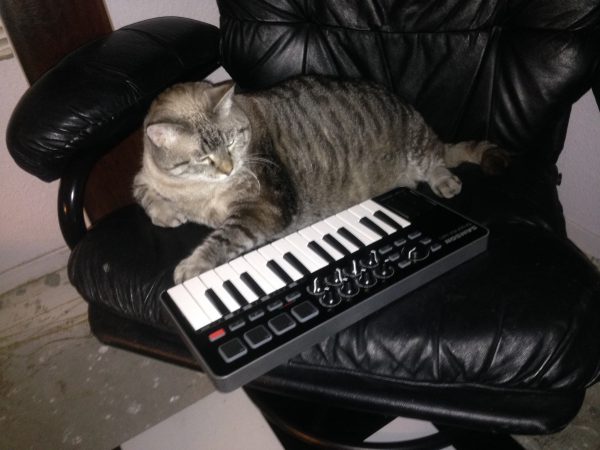
Jojodakat lounges with a Samson MIDI controller, getting ready for a solo synth jam. Submitted by Stephen Hammond via our Facebook page.


Jojodakat lounges with a Samson MIDI controller, getting ready for a solo synth jam. Submitted by Stephen Hammond via our Facebook page.

Skinny the cat shows off his Akai MPC Touch controller and software synths. We also see a bit of modular lurking in the corner 😺
Submitted by Alessandro Cilano via our Facebook page

Tuxedo cat “Agent” Cooper is ready to make music with his laptop M-Audio controller. From delicatedecay on Instagram.
delicatedecayAgent Cooper in his beat laboratory. 🎶👾💻🎹🤖🎶
From xmpla on Instagram. This is cat is learning how to lay down some beats in Ableton Live.
There is usually at least one completely out-there “what exactly is that” instrument at NAMM, and this year that was the SpaceHarp.
It is visually unique, looking a bit like something off the original Star Trek or other early science fiction. Each of the circles contains multiple optical and sonic sensors which respond when the performer moves and blocks the light from above. The input from the sensor arrays is converted to MIDI for controlling an external synthesizer. I’m not exactly sure what the large illuminated crystal does, but it adds the classic science-fiction quality of the instrument.

I did make an attempt to play the SpaceHarp.
It was fun, though not quite as easy to control as the description suggests. Given all the degrees of freedom, it was quite different from a theremin (even an optical theremin) in the way one interacts with it.
At a technical and visual level, the SpaceHarp was interesting. While it didn’t come across as a “must have” for me, I can see others finding this a useful and creative tool for live performance. The tendency towards New-Age hyperbole in their product literature was a bit of a turn-off, suggesting a different target audience. But perhaps it just needs another chance with some harsher and more abstract sounds, like from one of the many analog modules at this year’s show.
Our visit to Roger Linn Design featured both the man himself as we as the LinnStrument.

The LinnStrument is an expressive controller with a grid of continuous sensors that capture independent velocity, X, Y and Z-axis position for each of multiple touches. As such, it is an extremely expressive instrument that can afford control as dextrous as a traditional piano keyboard in some ways more versatile between all the degrees of freedom and abstract layout. It is also quite compact.

While the LinnStrument is primarily MIDI, it would be interesting to see it in a CV-based environment as well.
We were also treated to a demo by Roger Linn, including several of the featured sounds and programs.
We definitely appreciate his time talking with us and showing his invention.

From our friend Alex Ookpik (see what we did there?) via Instagram. Instagram is a great way to get your cat-and-gear pics onto the blog. Simply post to your feed and leave a comment on your post with “@catsynth”.
Oakland-based Visionary Instruments presented their new guitar-based MIDI controller at NAMM. Guitar-controllers are nothing new, but one is quite advanced, going beyond simple conversion of basic guitar fingering to include a wide variety of modern controls, including accelerometers and pressure sensitive pads in addition to an array of knobs, sliders and buttons.

Here we see Moldover demonstrating the basic version of the guitar. (We have reviewed Moldover’s performances in San Francisco in past articles.) You can see a little bit of the guitar in action in this video:
There was also a model with twelve strings and a more traditional finish. That one also had a built-in “e-bow”, which was a nice feature.
In addition to the controller, Visionary Instruments makes “video guitars” with embedded video screens. The main model has a stylized, curving shape, but I particularly liked this metallic retro model:

For those who look at such details, the video is Nigel Tufnel from Spinal Tap.
In addition to the quality of the instruments, it nice to see an innovative company from the Bay Area (and Oakland in particular) represented here.

Yesterday at NAMM I had a chance to see the new Keith McMillen Instruments QuNeo. It was a prototype, so it was demo-only at the time. It was definitely designed with Ableton Live in mind, with a layout and style that would be familiar to users. I liked the use of lighting to provide feedback, and the controller had a comfortable touch. In all, it seemed more “graceful” than the other Ableton Live controllers that have proliferated in the last few years. And it is about the size of an iPad. Which of course opens up the question of how such a controller compares to using an iPad. Certainly, the tactile feedback is helpful.
I would be curious to see how it does with other software or in a custom environment.